
Pre-production McDonnell-Douglas F-15 Eagles |
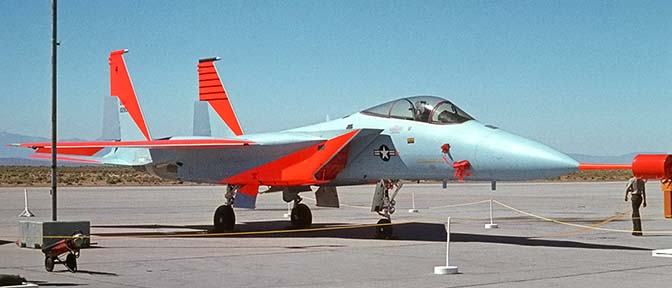 The fourth F-15A Eagle 71-0283 was displayed at the Edwards Air Force Base Open House on May 16, 1973. It was painted in Air Superiority Blue with dayglo high visiblity markings. It first flew on January 13, 1973. It was used as the structural test aircraft. It was assigned to the combined McDonnell-Douglas/USAF F-15 Joint Test Force at Edwards AFB in May 1973. Bailed to McDonnell Douglas as a test aircraft. It was withdrwan from use in 1998. It was transferred to Wright-Patterson Air Force Base for restoration. As of August 2003 it was preserved at the Defense Supply Center, in Richmond, Virginia. Photographer: Richard Lockett
The fourth F-15A Eagle 71-0283 was displayed at the Edwards Air Force Base Open House on May 16, 1973. It was painted in Air Superiority Blue with dayglo high visiblity markings. It first flew on January 13, 1973. It was used as the structural test aircraft. It was assigned to the combined McDonnell-Douglas/USAF F-15 Joint Test Force at Edwards AFB in May 1973. Bailed to McDonnell Douglas as a test aircraft. It was withdrwan from use in 1998. It was transferred to Wright-Patterson Air Force Base for restoration. As of August 2003 it was preserved at the Defense Supply Center, in Richmond, Virginia. Photographer: Richard Lockett
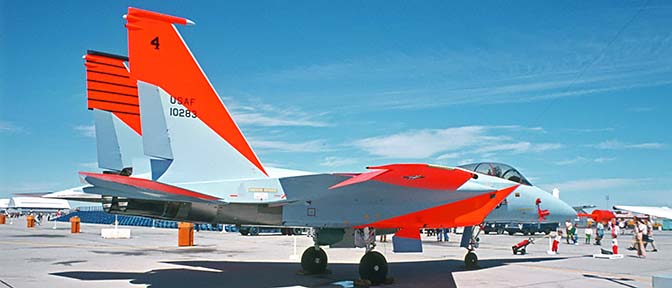 F-15A Eagle 71-0283 at the Edwards Air Force Base Open House on May 16, 1973. Photographer: Richard Lockett
F-15A Eagle 71-0283 at the Edwards Air Force Base Open House on May 16, 1973. Photographer: Richard Lockett
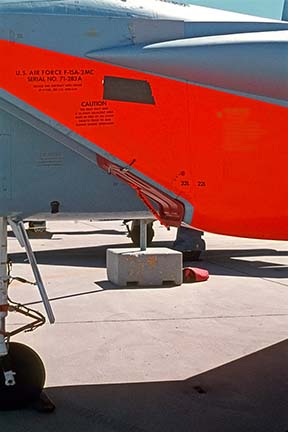 F-15A Eagle 71-0283 at the Edwards Air Force Base Open House on May 16, 1973. Photographer: Richard Lockett
F-15A Eagle 71-0283 at the Edwards Air Force Base Open House on May 16, 1973. Photographer: Richard Lockett
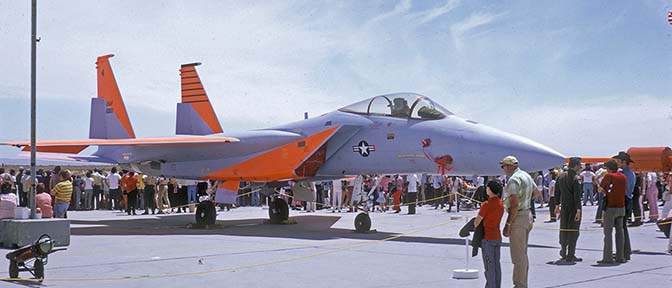 F-15A Eagle 71-0283 at the Edwards Air Force Base Open House on May 16, 1973. Later in the day the crowd had moved in. It was last reported at the Defense Supply Center at Richmond, Virginia.
F-15A Eagle 71-0283 at the Edwards Air Force Base Open House on May 16, 1973. Later in the day the crowd had moved in. It was last reported at the Defense Supply Center at Richmond, Virginia.
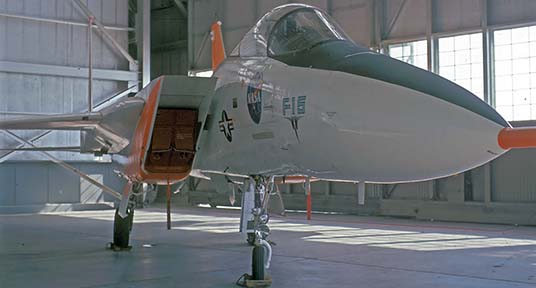 The second F-15A 71-0281 at the Edwards AFB open house on November 16, 1975. It first flew on September 26, 1972. It was used as the trials aircraft for the F-100 engine. It was assigned to the combined McDonnell-Douglas/USAF F-15 Joint Test Force at Edwards Air Force Base. It was bailed to NASA in 1975 and assigned to NASA Dryden Flight Research Center. It was painted white with high visibility markings. NaASA use it to test thermal protection tiles for the Space Shuttle. It was returned to the Air Force to be displayed at Langley AFB, Virginia in 1983.
The second F-15A 71-0281 at the Edwards AFB open house on November 16, 1975. It first flew on September 26, 1972. It was used as the trials aircraft for the F-100 engine. It was assigned to the combined McDonnell-Douglas/USAF F-15 Joint Test Force at Edwards Air Force Base. It was bailed to NASA in 1975 and assigned to NASA Dryden Flight Research Center. It was painted white with high visibility markings. NaASA use it to test thermal protection tiles for the Space Shuttle. It was returned to the Air Force to be displayed at Langley AFB, Virginia in 1983.
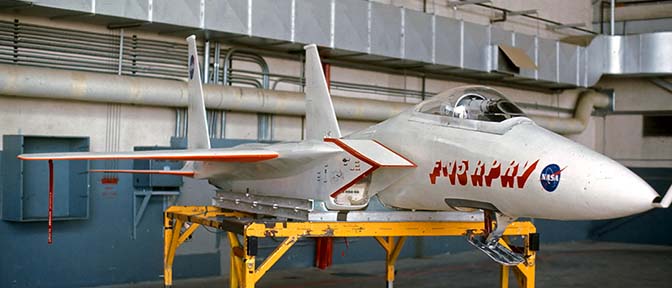 Two 3/8-scale F-15 Remotely Piloted Research Vehicles (RPRV) were built for hazardous tests. This one was displayed at Edwards AFB on November 16, 1975. They were launched from the NB-52B Stratofortress that had launched the X-15 and lifting bodies.Initially, they were retrieved by helicopters at the end of their flight. Later they were equipped with skid landing gear and landed on the dry lakebed.
Two 3/8-scale F-15 Remotely Piloted Research Vehicles (RPRV) were built for hazardous tests. This one was displayed at Edwards AFB on November 16, 1975. They were launched from the NB-52B Stratofortress that had launched the X-15 and lifting bodies.Initially, they were retrieved by helicopters at the end of their flight. Later they were equipped with skid landing gear and landed on the dry lakebed.
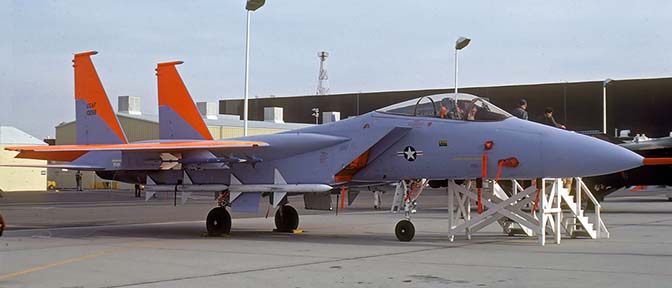 The ninth F-15A 71-0288 was displayed at Edwards AFB on November 13, 1977.
The ninth F-15A 71-0288 was displayed at Edwards AFB on November 13, 1977.
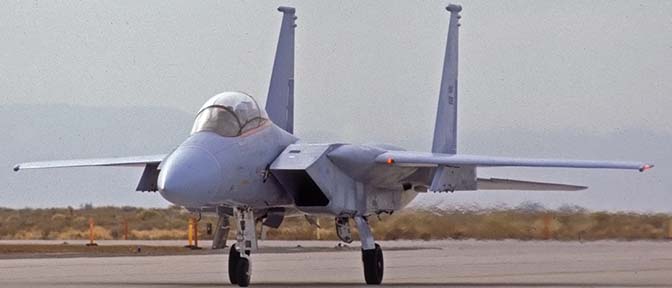 The first two-seat F-15B, 71-0290 at the November 13, 1977 Edwards Air Force Base Open House. It was designated as a TF-15A Eagle when it first flew on July 7, 1973. It was painted Air Supreriority Blue. It was assigned to the combined McDonnell-Douglas/USAF F-15 Joint Test Force at Edwards AFB from July 1973 to June 1983.
The first two-seat F-15B, 71-0290 at the November 13, 1977 Edwards Air Force Base Open House. It was designated as a TF-15A Eagle when it first flew on July 7, 1973. It was painted Air Supreriority Blue. It was assigned to the combined McDonnell-Douglas/USAF F-15 Joint Test Force at Edwards AFB from July 1973 to June 1983.
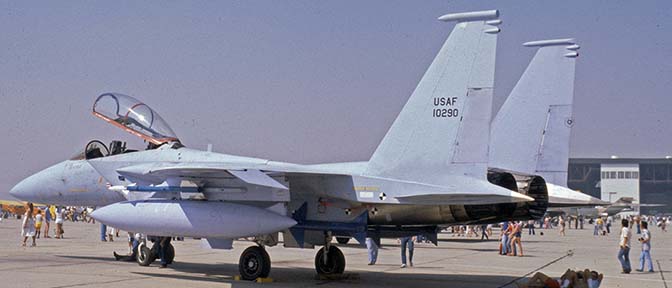 F-15B Eagle 71-0290 appeared on static display at the March Air Force Base Airshow on September 16, 1978.
F-15B Eagle 71-0290 appeared on static display at the March Air Force Base Airshow on September 16, 1978.
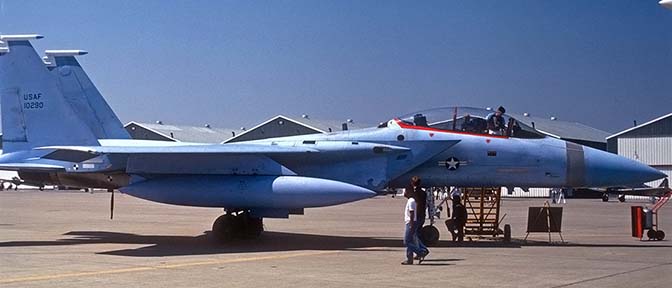 F-15B Eagle 71-0290 on static display at the Beale AFB Open House on May 31, 1980. Photogapher: Richard Lockett
F-15B Eagle 71-0290 on static display at the Beale AFB Open House on May 31, 1980. Photogapher: Richard Lockett
F-15B Eagle 71-0290 was bailed to McDonnell Douglas as a demonstrator and test aircraft in April 1984. On 1 October 1984, McDonnell Douglas became involved in the Agile Eagle program to develop a Short Take-Off and Landing (STOL) Maneuvering Technology Demonstrator (MTD).
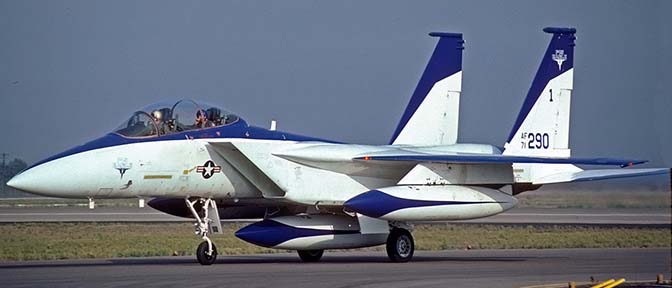 F-15B Eagle 71-0290 appeared at the NAWS Pt. Mugu Airshow on October 20, 1984 in special white and blue livery.
F-15B Eagle 71-0290 appeared at the NAWS Pt. Mugu Airshow on October 20, 1984 in special white and blue livery.
From Joe Baugher's NF-15B "Agile Eagle" page: The F-15 STOL/MTD aircraft was fitted with movable canard aerodynamic surfaces made from F/A-18 horizontal stabilizers attached to the upper edges of the forward air intakes. The canards were mounted at 20 degree dihedral and could be operated either symmetrically for pitch or differentially for roll control. It was provided with a four-channel fly-by-wire integrated flight/propulsion control (IFPC) system, and an improved set of cockpit controls and displays. The aircraft was fitted with a beefed-up undercarriage capable of handling rough field landings at high rate of descent. The APG-70 radar of the F-15B was provided with a high-resolution ground-mapping mode to enable the pilot to locate the airfield from a great distance, and a LANTIRN set was fitted to the aircraft to project an image of the airfield onto the HUD during the final landing approach.The integrated flight/propulsion control (IFPC) system was developed by McDonnell Douglas and produced by General Electric. The IFPC manages all control parameters for the aircraft. It uses a new computer chip and employs high-level computer languages such as Ada. The system is intended to relieve the pilot of some of the more routine tasks of handling the aircraft. There are five modes of operation--conventional, short takeoff/approach, short landing, cruise and combat. Position sensors linked to the throttle, control stick and rudder pedals feed electrical signals to the IFPC system, and the computer converts them into a set of commands to the quadruply-redundant fly-by-wire activators to set the controls for the maneuvers required.
The modified 71-0290 flew for the first time on September 7, 1988, company test pilot Larry Walker being at the controls The aircraft was assigned the designation NF-15B. 43 test flights were carried out in this configuration.
The modified McDonnell-Douglas NF-15B Short Take-Off and Landing/Manuever Technology Demonstrator (STOL/MTD) Eagle, 71-0290 first appeared on static display at the Edwards Air Force Base Open House on October 29, 1989.
Short Take-Off and Landing/Manuever Technology Demonstrator badge on the tail of NF-15B (STOL/MTD) Eagle 71-0290.
In the second phase of the program, the standard circular dilating engine nozzles were replaced with rectangular two-dimensional thrust-vectoring, thrust-reversing nozzles. These nozzles were built by Pratt & Whitney out of chemically-milled, welded titanium honeycomb. They had flat upper and lower flaps that were independently driven and capable of adjusting the exhaust upwards or downwards by angles as much as 20 degrees. There were a set of vanes above and below the nozzle that made it possible for the thrust to be reversed.
The first flight with the thrust-vectoring nozzles took place on May 16, 1989. The plane was transferred to Edwards AFB for joint flight tests by the Air Force and McDonnell Douglas on May 25, 1989. The two-dimensional nozzles were first tested in flight on March 23, 1990. Test flights demonstrated that the thrust-vectoring features of the new nozzles worked as anticipated and validated the changes that had been made to the IFPC system software in order to accommodate the new thrust-vectoring nozzles. It turned out that thrust-vectoring resulted in a 25 percent reduction in takeoff roll. The thrust-reversing feature made it possible for the F-15 to land on just 1650 feet of runway. In addition, it was found possible to use thrust reversal during actual flight to produce rapid decelerations, a useful feature to have during close-in air-to-air combat. During its flying life, the F-15 STOL/MTD made numerous vectored takeoffs with rotation demonstrated at speeds as low as 42 mph. The shortest landing made by the plane took only 1366 feet, with a basic F-15 needing 7500 feet to land.
The program ended on August 15, 1991, having accomplished all of its flight objectives. The vectored thrust nozzles were returned to Pratt & Whitney. The NF-15B was retired and stored at the McDonnell Douglas factory in St Louis.
The NF-15B was assigned to NASA on June 15, 1993, and registered as NASA 837.
Following the completion of the vectored thrust tests, the NF-15B was fitted with new thrust-vectoring nozzles. They are known as pitch/yaw balanced beam nozzles, and can deflect thrust up to 20 degrees in any direction. F100-PW-229 IPE engines. The program is known as Advanced Control Technology for Integrated VEhicles (ACTIVE). The goal of the program is to explore thrust vectoring in the supersonic regime, as well as to explore the possibility of using thrust vectoring to replace vertical tailfins. Initial flight trials begain in February of 1996. The first thrust vectoring flights took place shortly thereafter. The first supersonic thrust vectoring took place on April 24, 1996. On October 31, 1996, the aircraft demonstrated thrust vectoring at Mach 1.95.
The next program for the aircraft to be involved in was that of the F-15 Intelligent Flight Control System (IFCS), which lasted from 1999 to 2008. The IFCS allowed the aircraft to be safely controlled with various degrees of damage to the airframe; sensor input allowed the aircraft’s computer to react to changing flight parameters. NASA registered the NF-15B as N837NA on July 23, 2001.
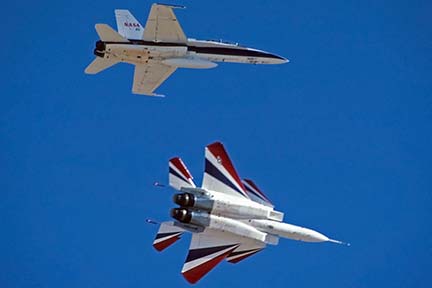 NF-15B STOL Demonstrator NASA 837 breaks into the pattern for Runway 22 at the Edwards Air Force Base open house on October 9, 1999. Its Pratt & Whitney F100-PW-229 engines are equipped with 360-degree thrust vectoring nozzles.
NF-15B STOL Demonstrator NASA 837 breaks into the pattern for Runway 22 at the Edwards Air Force Base open house on October 9, 1999. Its Pratt & Whitney F100-PW-229 engines are equipped with 360-degree thrust vectoring nozzles.
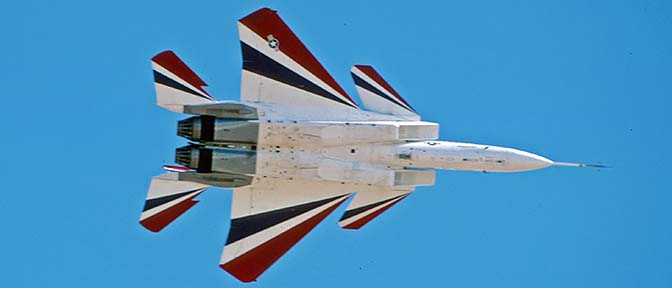 Plan view of McDonnell-Douglas NF-15B STOL Demonstrator NASA 837 at the Edwards Air Force Base open house on October 10, 1999.
Plan view of McDonnell-Douglas NF-15B STOL Demonstrator NASA 837 at the Edwards Air Force Base open house on October 10, 1999.
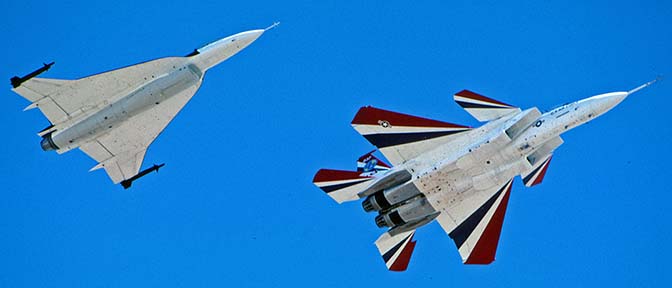 General Dynamics F-16XL N849NA flies in formation with the NASA NF-15B STOL demonstrator at Edwards Air Force Base on October 10, 1999.
General Dynamics F-16XL N849NA flies in formation with the NASA NF-15B STOL demonstrator at Edwards Air Force Base on October 10, 1999.
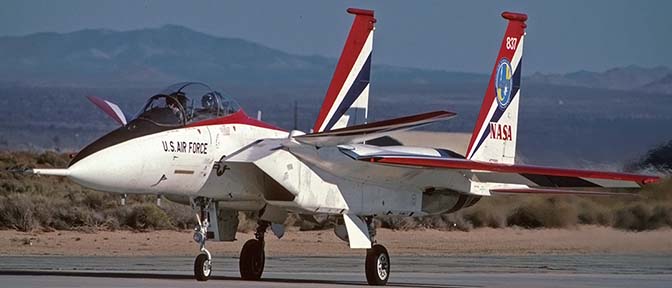 NF-15B STOL Demonstrator NASA 837 at Edwards Air Force Base on October 10, 1999.
NF-15B STOL Demonstrator NASA 837 at Edwards Air Force Base on October 10, 1999.
 NF-15B ACTIVE NASA 837 and F-15B-12-MC NASA 836 at Edwards Air Force Base on October 21, 2000.
NF-15B ACTIVE NASA 837 and F-15B-12-MC NASA 836 at Edwards Air Force Base on October 21, 2000.
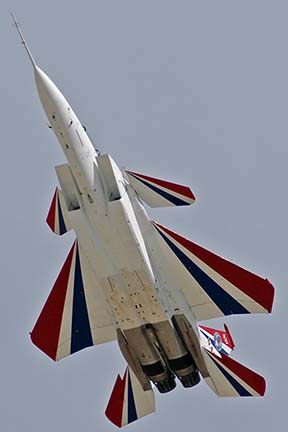 NASA NF-15B Eagle N837NA takes off from Runway 22 at Edwards Air Force Base on October 21, 2005. It is the Intelligent Flight Control System (IFCS) flight research project testbed aircraft.
NASA NF-15B Eagle N837NA takes off from Runway 22 at Edwards Air Force Base on October 21, 2005. It is the Intelligent Flight Control System (IFCS) flight research project testbed aircraft.
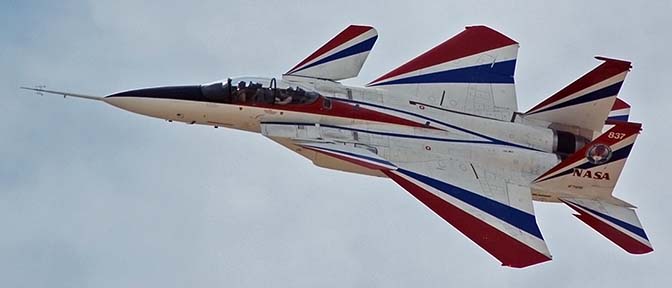 NASA NF-15B Eagle N837NA at Edwards Air Force Base on October 21, 2005.
NASA NF-15B Eagle N837NA at Edwards Air Force Base on October 21, 2005.
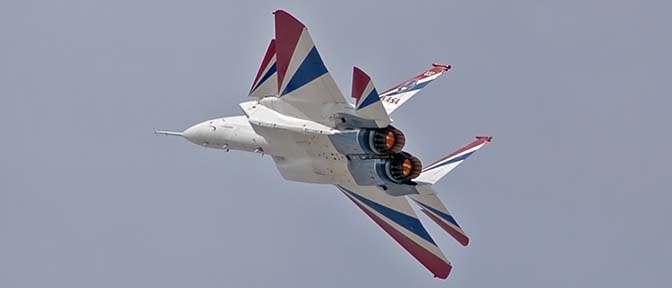 NASA NF-15B Eagle N837NA at Edwards Air Force Base on October 21, 2005.
NASA NF-15B Eagle N837NA at Edwards Air Force Base on October 21, 2005.
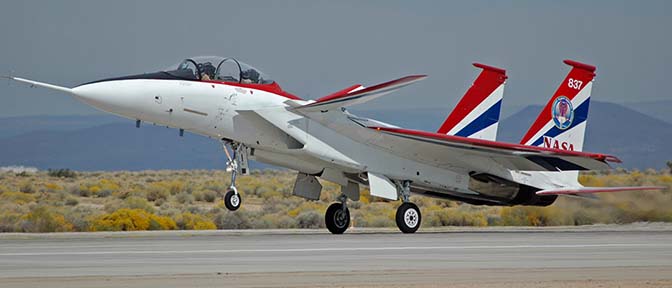 NASA NF-15B Eagle N837NA at Edwards Air Force Base on October 21, 2005.
NASA NF-15B Eagle N837NA at Edwards Air Force Base on October 21, 2005.
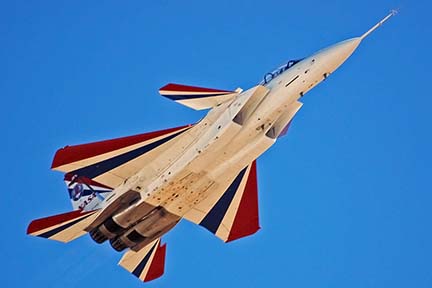 NASA NF-15B Eagle N837NA at Edwards Air Force Base on October 22, 2005.
NASA NF-15B Eagle N837NA at Edwards Air Force Base on October 22, 2005.
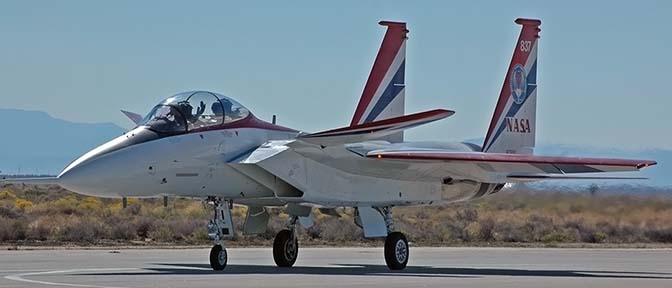 NASA NF-15B Eagle N837NA at Edwards Air Force Base on October 22, 2005.
NASA NF-15B Eagle N837NA at Edwards Air Force Base on October 22, 2005.
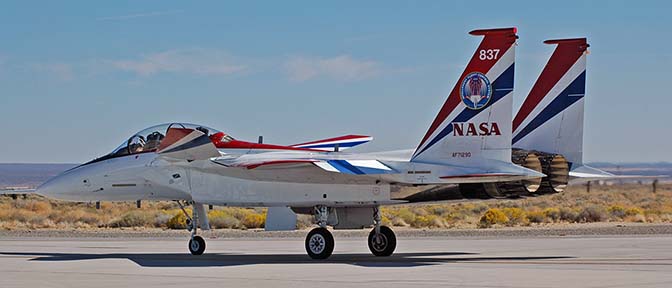 NASA NF-15B Eagle N837NA at Edwards Air Force Base on October 22, 2005.
NASA NF-15B Eagle N837NA at Edwards Air Force Base on October 22, 2005.
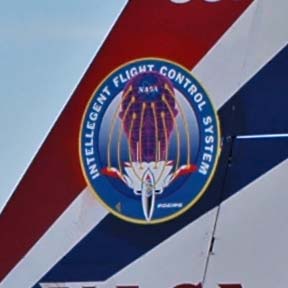 Intelligent Flight Control System badge on the tail of the NASA NF-15B Eagle N837NA at Edwards Air Force Base on October 22, 2005.
Intelligent Flight Control System badge on the tail of the NASA NF-15B Eagle N837NA at Edwards Air Force Base on October 22, 2005.
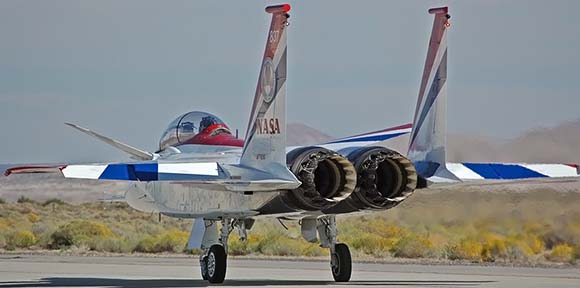 NASA NF-15B Eagle N837NA at Edwards Air Force Base on October 22, 2005.
NASA NF-15B Eagle N837NA at Edwards Air Force Base on October 22, 2005.
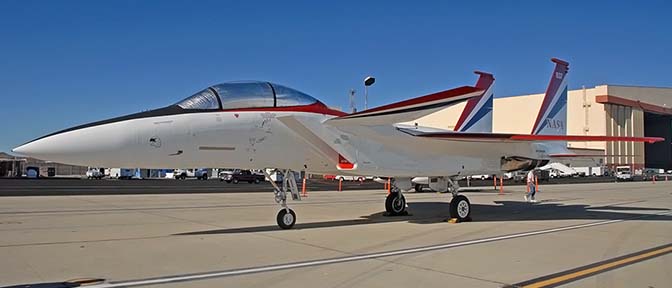 NASA NF-15B Eagle N837NA at Edwards Air Force Base on October 16, 2009. It had made its last flight on January 30, 2009.
NASA NF-15B Eagle N837NA at Edwards Air Force Base on October 16, 2009. It had made its last flight on January 30, 2009.
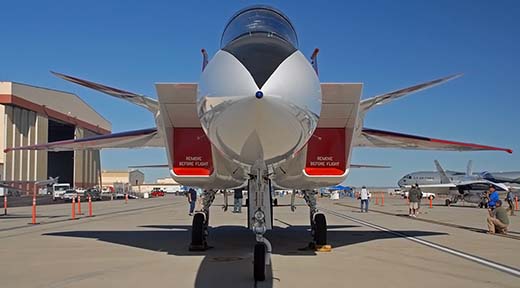 NASA NF-15B Eagle N837NA at Edwards Air Force Base on October 16, 2009.
NASA NF-15B Eagle N837NA at Edwards Air Force Base on October 16, 2009.
 US Air Force Pre-production Jet Fighters
US Air Force Pre-production Jet Fighters
 Send a message to Brian.
Send a message to Brian.